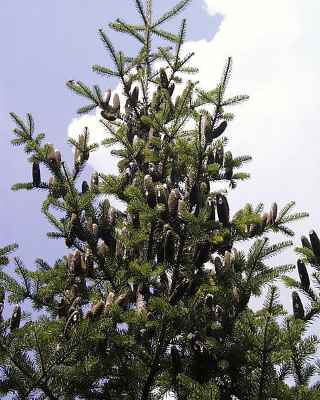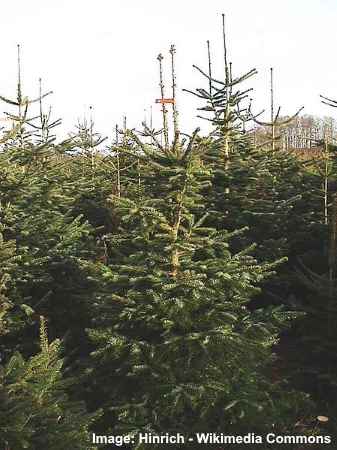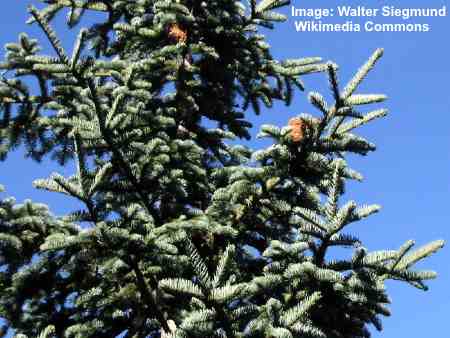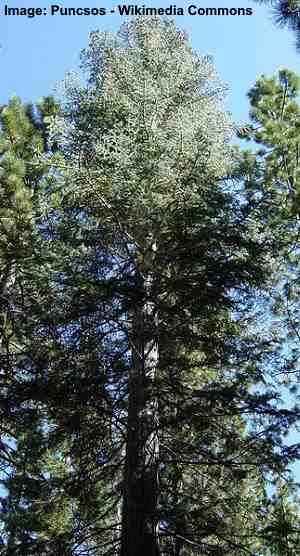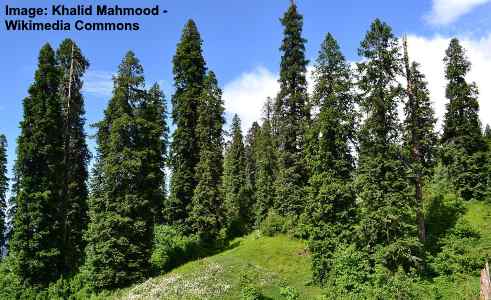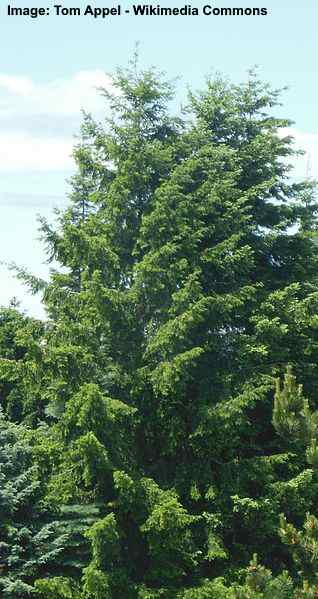Types of Fir Trees with Identification Guide and Pictures

Fir trees are a species of large evergreen conifer trees that are mainly found in North America, Europe, and Asia. Some of the tallest types of fir trees can reach impressive heights of 262 ft. (80 m) and some smaller kinds may only be 32 ft. (10 m) tall. Like most coniferous trees, firs have needle-like leaves that stay green all year long. Some species of fir tree such as the Fraser fir, balsam fir, and noble fir are popular Christmas trees.
Fir trees are woody plants that belong to the genus Abies. They are closely related to other coniferous trees in the family Pinaceae such as pines and cedars. Knowing the scientific name of true fir trees can help to identify them. For example, the Douglas fir belongs to the genus Pseudotsuga which means that it is a type of pine tree, not a fir tree.
Fir tree wood is a type of softwood that has no resistance to decay or disease. Because of this, wood from fir trees is generally used to construct indoor wooden frames or plywood. These large evergreens are also widely used for rough timber or paper pulp.
In this article, you will learn about the many different species of fir trees and how to identify them. Apart from the botanical names and descriptions of these evergreens, pictures will provide identification for each type of fir tree.
Fir Tree Identification
The easiest way to identify fir trees is by looking at their needles and cones. Although they look similar to pine trees or spruce trees, the needle-like leaves and the types of cones help to tell them apart.
Fir Needles Identification
The needle-like leaves of fir trees tend to be softer than pine or spruce. Unlike the clusters of pine needles on a branch, the needle-like leaves of fir tree attach individually to the branches and not in clusters or attached to small woody projections.
Fir Tree Cones Identification
Another way to tell firs apart from pines or spruces is by their cones. The cones are the fruit of the conifers and fir cones tend to grow straight upward from the branches. Growing on the fir trees, these cones can resemble candles on a Christmas tree.
Fir Tree Bark Identification
The bark of young fir trees is usually smooth and gray. As the tree matures the bark becomes ridged.
Different Types of Fir Trees With Their Image and Common Name
Let’s look in more detail at the many types of woody plants that belong to the fir tree genus.
Noble Fir Tree (Abies procera)
This large fir tree is a popular type of fir that lives up to its common name of being noble. This is one of the tallest types of fir tree and its botanical name procera literally means tall. Dwarf varieties of these evergreens are some of the most popular Christmas trees.
In coniferous forests, noble fir tree grows where they get full sun and partial shade. Their needle-like leaves are between 0.4″ and 1.37″ (1 – 3.5 cm) long and are a bluish-green color. If you look closely at pictures of the needles, you will see they are arranged in a spiral on the shoots.
Cones on noble firs are long and cylindrical and can grow to between 4” and 9” (10 – 22 cm) long. These fir cones are yellowish-green when immature and gradually turn brown.
The bark of noble fir trees is reddish-brown when mature.
Fir tree identification
Noble firs grow to between 130 and 230 ft. (40 – 70 m) tall. They have soft blue-green needles that have blunted tips.
Balsam Fir (Abies balsamea)
The balsam fir tree is a species of evergreen coniferous tree that has dense dark green needles. Also called the Canaan fir, these fir trees are described as medium-sized trees that have a thick sticky aromatic resin.
There are many reasons why the balsam fir has become a popular type of Christmas tree. It has a delightful fragrant aroma and soft flat green needles that stay on the tree after being cut. Also, the balsam fir tree has the classic pyramid spherical shape of Christmas trees.
Needles on the balsam fir are typically soft and have a rich green color. These needle leaves are arranged spirally on the branches but they appear to be in 2 horizontal rows. As with most fir trees, the long cones grow erect on the stems. The balsam fir tree has grayish bark.
These coniferous trees prefer cooler climates where they get full sun.
Fir tree identification
Balsam firs grow to between 46 and 66 ft. (14 – 20 m) tall with some of the tallest trees reaching 90 ft. (27 m). The balsam fir is identified by its flat needles that grow to 1.18” (3 cm) long. Cones are dark purple to brown and grow to between 1.5” and 3.14” (4 – 8 cm) long.
Nordmann Fir (Abies nordmanniana)
Also named the Caucasian fir tree, the Nordmann fir is native to Europe, Russia, and the Caucasus mountains. These fir trees are some of the tallest fir trees in their native habitats.
Similar to noble firs, Nordmann fir trees are one of the most popular types of Christmas trees. The soft fir needles stay on the shoots for a long time after the tree is cut. Another reason why these evergreens are popular at Christmas time is due to their glossy green foliage. The needles are dark green with blunted ends.
Nordmann fir trees are also used for rough timber to construct indoor wooden frames. These are also an important type of tree for its pulp to make paper.
Fir tree identification
Some of the tallest specimens of Nordmann trees can grow up to 280 ft. (85 m) tall. However, the typical height of these firs is between 180 and 200 ft. (55 – 61 m). The cones are cylindrical in shape, 6” (15 cm) long, and have a reddish-brown color.
Grand Fir (Abies grandis)
This fir tree lives up to its common name of grand fir because it is one of the tallest trees in the firs (Abies) genus. Other descriptive names of this fir include giant fir, western white fir, and great silver fir.
The grand fir tree has soft needle leaves that are dark green and glossy. These grow from the shoots on either side, giving the “leaf” a flat rather than cylindrical look. The fir needles have a distinct citrus aroma.
The grand fir tree has smooth bark that is grayish brown and becomes scaly as the tree matures.
Although the grand fir is a type of softwood tree, its wood is strong and cut into timber. Often wood from grand firs is used in the construction industry for frames and other wooden indoor structures.
Fir tree identification
This grand fir tree grows up to 230 ft. (70 m) tall and has a conical pyramid shape. Its flattened needle leaves help to identify this Abies species along with green cones that grow to between 2.3” and 4.7” (6 – 12 cm) long.
California Red Fir Tree (Abies magnifica)
The scientific name of the California red fir gives a clue as to its size and stature. This is a magnificent tree which is among the taller species of fir trees. As with most fir trees, branches from the lower part drop off, meaning that foliage is concentrated at the top of the tall tree.
The bluish-green leaves are needle-like and measure about 1.2” (3 cm) long. One of the unique identifying features of this fir tree is its long yellowish-green cones. They can grow up to 8” (21 cm) long and stand erect on branches as they mature to a brown color.
As its common name suggests, the California red fir tree develops reddish bark. As the fir tree matures, the bark changes from smooth and soft to rough and fissured.
Fir tree identification
These huge fir trees grow to between 130 and 200 ft. (40 – 60 m) tall and their trunk is 6.6 ft. (2 m) in diameter. The light bluish fir needles help identify California red firs as they are shaped like a hockey stick. These needles help to tell this fir apart from the noble fir, which is closely related.
White Fir (Abies concolor)
Although many species of fir have a common name “white fir,” the Abies concolor is a distinct species. The name comes from the fact that the needle foliage has a whitish appearance on the underside.
The White fir has soft needles that are light bluish-green above, and measure up to 2.3 (6 cm) long. They have slightly blunted tips that curl at the ends. The way the fir needles are arranged on the shoots gives the “leaf” an overall flat appearance.
Bark on white firs is light gray, and younger specimens have smooth bark. As the tree grows, the bark becomes ridged and takes on a light brown color.
Fir tree identification
White firs are among the tall species of woody plants in the Abies genus. They can grow to between 80 and 195 ft. (24 – 60 m). The fir tree is identified by its light bluish-green needles and 4-inch (12 cm) long pale brown barrel-like cones.
Fraser Fir (Abies fraseri)
Fraser fir trees are small evergreen coniferous trees with thin trunks and soft dark-green needles. A distinguishing feature of the Fraser fir is that it has straight branches that are angled upwards.
The foliage forms a conical shape at the top of the tree. Each branch has twigs with short green to dark-green needles that grow in 2 rows. These give off a mild turpentine-like fragrance when crushed.
Bark on Fraser fir trees has a grayish-brown appearance that becomes scaly as the tree matures. Fraser fir tree has small conical cones that are purple in color that turns light brown before disintegrating and spreading seeds.
Fraser firs are one of the most popular types of Christmas trees due to their mild sent, soft needles, and good conical shape.
Fir tree identification
These small conifers grow to between 30 and 50 ft. (10 – 15 m) tall. Identifying features are the 2 rows of green needles on each twig and small fat light-brown colored cones.
West Himalayan Fir (Abies pindrow)
Also called the pindrow fir, this species of fir tree grows large and has a distinctive long slender conical shape. These trees native to India and Pakistan and require a lot of humidity and rainfall to grow well.
West Himalayan firs have needle-like leaves which are the longest of any fir species. The needles grow up to 3.5” (9 cm) long and are soft and glossy. The underside of the needles has 2 white stomatal bands giving the foliage a lighter appearance.
The cones of this pindrow fir are broad and large. They can grow up to 5.5” (14 cm) long and measure 1.6” (4 cm) wide.
Fir tree identification
The west Himalayan fir grows to between 130 and 200 ft. (40 – 60 m) tall. The tree is identified by the fact that it has foliage almost the whole length of its trunk. The needles are soft and are dark glossy green in color.
Korean Fir (Abies koreana)
One of the smaller species of fir tree is the Korean fir that has a short shrub-like appearance. These evergreens grow at high altitudes in temperate forests that get plenty of rainfall.
Due to their short stature and conical shape, you are likely to see these trees in ornamental gardens. Unlike many types of fir where the foliage only grows at the top, the whole shape of the tree is conical. The needles of Korean fir grow densely on the twigs and curl in on themselves.
One of the attractive features of Korean firs is their large plump purple cones. These can be up to 3” (7.6 cm) long and 0.8” (2 cm) wide. Unlike many types of fir trees, the cones also appear on young trees which enhance their attractiveness.
Fir tree identification
Korean firs are small ornamental trees that grow to between 33 and 60 ft. (10 – 18 m). The identifying features of these firs are short flattened needles, long purple cones, and bushy foliage.
Silver Fir Tree (Abies alba)
The silver fir tree is native to Europe and is a tall species of conifer with sparse foliage. European silver firs are also popular Christmas trees in North America and Europe.
Silver firs have leaves that are needle-like and have a dark glossy appearance. The needles are around 1.18” (3 cm) and have notched tips. Cones are large and can be up to 7” (18.7 cm) long and 1.6” (4 cm) broad.
The distinctive triangular shape of the young varieties, its fresh mild aroma, and long-lasting needles have made this a popular tree at Christmas time. If you look at pictures of mature silver firs, you can often see the distinctive pyramid shape at the very top of the tree.
Fir tree identification
The silver fir is slender tree that grows to between 130 and 160 ft. (40 – 50 m) tall. The needles on the twigs are dark green on the upper side with 2 white stomata bands on the underside.
Spanish Fir (Abies pinsapo)
Spanish fir trees grow in high altitudes in Spain and Morocco. The evergreen conifers have a distinct conical shape, even when mature.
Looking up close at the needle leaves, you will see that Spanish fir has light bluish-green needles are arranged radially. Depending on the tree, there may be a whitish waxy substance on the needles.
The Spanish fir is closely related to the Moroccan fir which has slightly longer cones on it.
Fir tree identification
Spanish firs are a small-medium type of evergreen plant that grow to between 65 and 98 ft. (20 – 30 m) tall. Small needle-like leaves also dominate this tree species as well as large cylindrical purple cones.
Subalpine Fir (Abies lasiocarpa)
Also called the Rocky Mountain fir, this medium-sized evergreen grows at high altitudes in cold humid climates. The shape of the slender fir tree appears to taper to a point.
Needles that make up the “leaves” are light pale-green and flat. These are arranged spirally on the twigs and are slightly curved in shape.
As with many species of fir tree, the bark on subalpine firs is smooth on young trees and gradually becomes scaly as the tree ages.
Long cones grow erect on the tree and they can be between 2.1” and 4.3” (6 – 12 cm) long. As the cones mature, they change in color from dark purple to brown before disintegrating.
Fir tree identification
Subalpine firs grow up to 66 ft. (20 m) and are also popular in ornamental landscaped gardens. Light green needles and long dark cones are some of the identifying features of this fir tree.
Douglas Fir (Pseudotsuga menziesii)
As you may be able to tell by its scientific name, the Douglas fir is not a true fir tree. This species of evergreen conifer is from the genus Pseudotsuga which means it actually belongs on the list of pine trees.
Depending on where this “fir” tree is found in the world, it is also called the Oregon pine, Douglas spruce, red fir, or red pine.
These are large evergreen trees in the family Pinaceae that grow up to 330 ft. (100 m) tall. Their needle-like leaves are similar to fir trees and generally only grow nearer the top of the tree trunk. Unlike fir trees, the large brown cones don’t grow erect but droop from the branches.
Douglas fir is a hard type of softwood tree that is used for flooring, construction, veneer, and for general timber. Dwarf varieties of Douglas fir are also popular Christmas trees.
Related articles:


